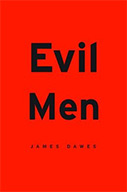Evil Men
 Author: James Dawes
Author: James Dawes
Publisher: Cambridge, MA: Harvard University Press, 2013. 280p.
Reviewer: Mark A. Drumbl | September 2013
Crimes against humanity, genocide, and war crimes are collective undertakings, to be sure, but they accumulate from the handiwork of many ordinary individuals. So, what prompts a regular foot soldier to torture a captive? To rape dozens of civilians? To mow down children?
These questions attract a great deal of scholarship from diverse disciplines, including psychology, sociology, history, and criminology. Philosophy, too, has contributed. For example, Hannah Arendt’s ground-breaking Eichmann in Jerusalem unleashed waves of debates – still churning – regarding the posited supplication of the Judenräte and the purported normalcy of Eichmann himself. Yet much of this scholarship tends to drift towards the leaders or higher-ups – such as Arendt’s own work. When it comes to research on ordinary folks, moreover, existing scholarly findings remain unsettled. We are, after all, still angsting about Stanley Milgram’s experiments, while critiquing their results, methodologies, and ethics.
Literature also has a lot to say about cruelty. Literary accounts telegraph the agony of electrocution, the sound of steel severing bones, and the mess of the violence. Mario Vargas Llosa’s semi-fictional Feast of the Goat overwhelms in its searing account of Dominican torture chambers. Literary accounts also portray the clumsiness of spontaneous confrontation between the torturer and the tortured, such as Ariel Dorfman’s Death and the Maiden, and the emptiness of post-conflict reconciliation.
James Dawes’ Evil Men merges the rawness of storytelling with the rigor of scholarly inquiry. Through extensive and free-ranging interviews with several elderly Japanese war criminals, Dawes channels the power of narrative. He brings to light the how, why, and thereafter of the atrocities the Japanese Red Army inflicted throughout occupied China. The vivisections, the medical experiments, and the distended intestines scar the text. He elucidates how a number of seemingly well-adjusted, courtly, and kind gentlemen had serially engaged in acts of brutal sadism while they were youths enmeshed in war.
The stories told by Dawes’ interviewees rivet while they repel. At times, my fingers itched on the pages recounting the violence – an itch to flit over pages, not to dig into them, and to alight instead on the more comforting and anodyne theoretical discussion. Dawes’ scholarly review is capacious and panoramic, without succumbing to dilettantism. The jarring contradiction, and energetic synergy, between the realities of atrocity and the theories of atrocity render this book singular in its approach. By engaging with low-ranking Japanese perpetrators, Dawes addresses one among the least considered aspects of World War II. For this alone, Dawes’ work is a must read. But it also offers much more.
Dawes’ interviewees are all former members of a group known as the Chukiren. As Dawes describes them, the Chukiren were an association of Japanese anti-war veterans. The Chukiren numbered approximately 1,100. Dawes’ account of how they became killers meshes with Arendt’s theory of how normal people become joiners in the mechanization of genocide. Branded upon capture as war criminals, the Chukiren were extradited from the hell of a Soviet gulag to the Fushun reeducation camp in China. One of Dawes’ interviewees, Takahashi-san, cannot forgive the people in Siberia who treated them so harshly. Fushun, however, achieved its goal through gentle methods. The Chukiren read books on Marx and Lenin and by Mao Tse-tung. Then they returned to Japan, where they expended lifelong efforts to draw attention to Japanese war crimes, promote friendship between Japan and China, advance a leftist political agenda, and encourage pacifism. For another inteviewee – Kaneko-san – these efforts constituted his repentance for his crimes. He is forgiven, he says, because he won’t fight such a war twice.
Once war ends and peace begins, many perpetrators of war crimes quietly return home. They slink into routine day-jobs and start new families. They live cloaked in silence and denial. The Chukiren, however, prefer discussion, admission, and contestation. In this sense, the Chukiren – around whom Dawes builds his exploration of perpetration – are atypical perpetrators. The Chukiren were key agents in challenging the flatness of Japanese obfuscation of World War II crimes and the opacity of governmental constructs of the violence. For this alone, the Chukiren deserve great credit. By the end of the book, however (and however embarrassing), I felt antipathy towards them – a bitterness I might not feel towards the perpetrator who denies, or who still seeks to pathetically justify, the crimes.
Dawes knowingly plays into his informants’ hands. While befriending them to generate material for his book, he gifts them with authoritative space for repentance. Yet they may dissemble; their contrition may be more about self-servingly cleansing themselves than redressing what they actually did. A codependency emerges. In exchange for their nightmarish stories, Dawes affords the Chukiren reprieve in their final years. Perhaps this is why they are so eager to talk to him and be raconteurs of gore; and perhaps explains why Kubotera-san sits there, without movement and in great physical discomfort, until the end of the interview. In addition to their private pursuit of redemption, the Churiken have a public political goal – namely, an antinationalist pacifism – which they see as buttressed by the recounting of their stories. So perhaps these Chukiren even exaggerate their brutalities (Dawes doesn’t think so, however). In any event, the heroism of redemption may be measured by the depth of the depravity to be overcome. Is it, then, so surprising that the kids tell one father not to bullshit (21)?
Dawes tends to anonymize the people his Chukiren interviewees raped, shot, and butchered. The comfort women are interchangeable, the villages are generic, the tortured nameless, and the children described by guesstimating their ages. While the perpetrators are vivified and humanized, the victims – whether dead or alive – remain chattel. The stories of what happened to their bodies, their flesh, their organs, to be sure, are detailed. But these stories are delivered to us in the voice of the abusers. Evil Men accords Yuasa-san the platform to memorialize the comfort women as “ugly,” as “vile women,” as “really disgusting,” and nothing but “sex tools” (90). The differentiation drawn between the comfort women (who couldn’t be raped because they cost money) and the women the Chukiren raped (who didn’t cost a penny!) is a one-way conversation.
We learn little from the victims. We know nothing about the crimes other than what the perpetrators say about them. Dawes cannot be chided for this gap. After all, his book is about perpetrators. But this narrative blind-spot is one reason why, as more and more of the testimonies emerged, I began to skip over them. Their presentation as monologue renders them all the more lurid. The perpetrators’ grip over the victims has never relaxed. And the more the perpetrators talk about what they did, the tighter that grip becomes. The victims are both the Chukiren’s fall from grace as well as essential to their recovery. Convalescing from the cruelties they authored nourishes the Chukiren’s will to live. Their crimes do not enervate them, but rather seem to energize them. The suffering of the comfort women, the villagers, the tortured, and the murdered children become the lyrics of the Chukiren’s redemption songs.
Undeniably, tout comprendre, c’est tout pardonner. Any work about perpetrators will inevitably pull towards this amoral end. I experienced the tautness of this pull in my own legal work with low-level, illiterate Rwandan génocidaires. I also sought to befriend them so as to best represent them. But the process of law requires victims to step forward as human beings and tell their stores in their words. The perpetrator does not monopolize that conversation.
Although reticent about the victims, Dawes is garrulous when it comes to himself. The book is peppered with Dawes’ anxieties. He frets about why he is undertaking this project, worries about its effects, ruminates about his position of privilege, and uses neuroticisms in his relationships with his interpreter and photographer. Dawes connects his own fears with broader questions about the role of the outside human rights worker, researcher, and writer. Dawes seeks to atone for his very interest in the project. The binary oscillations in text between the perpetrators’ stories, on the one hand, and what researchers say about perpetrators, on the other, thereby become three-dimensional. And in this process the text becomes tinged with self-indulgence. The act of telling us that he does not want to be a narcissist (37-38) itself becomes an exercise in narcissism. Dawes is not the first – and far from the last – person to drink at night and laugh a lot while spending the day engaging with perpetrators. I did, too. And ironically many perpetrators also spend their days killing and their evenings laughing a lot while drinking.
Dawes’ writing is elegant. Evil Men is neither human rights stenography nor human rights pornography. Without the encumbrance of chapters, the book flows quickly. It pivots and surprises at every turn. Dawes excels at preserving the vacillating crudeness of the interviews he excerpts. Kaneko-san begins with denying that he murdered any child, to recounting the one 4 year-old he blew up in a well (after having thrown the boy’s mother down it), to how he closed his eyes when he machine-gunned kids indiscriminately (100-102). In between, Dawes notes the inaudible, the silence, the pauses, the diminishing voice, and the cough. The reader can hear Kaneko-san and feel him breathe.
I was left wondering about Dawes’ choice of title – Evil Men – and his opening description of perpetrators as “monsters” (xii). For a work of such exhilaratingly frustrating nuance, these words grate in their simplicity. Perhaps the title signals the author’s starting point, which he retained as a memento of his own journey. Certainly, by the end, Dawes’ nimble engagement with the Chukiren dispels the suitability of these words as their epitaphs.
Mark A. Drumbl is the Class of 1975 Alumni Professor of Law and Director of the Transnational Law Institute at Washington and Lee University. He is the author of Atrocity, Punishment, and InternationalLaw (CUP, 2007) and Reimagining Child Soldiers in International Law and Policy (OUP, 2012).


